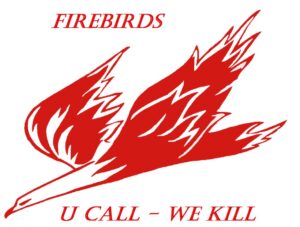
The mundane but necessary first few weeks in the 71st provided a variety of flying experiences. Learning the 196th AO of almost 3,000 square miles of rice paddies, sandy South China Sea beaches, and the bordering Laos mountainous terrain prepared you for further adventures during your tour of duty.
The 196th Light Infantry Brigade (LIB) with headquarters at LZ Baldy supported the 1/46, 2/1, 3/21, and 4/31 Infantry Regimental Battalions located at semi-permanent fire support bases throughout the AO. Navigation to these areas must be committed to memory without map assistance.
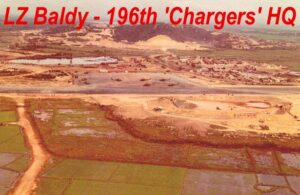
A topographical map of the AO was used only when locating small or remote unit field locations assigned to the various battalions. Helicopter combat assaults (CA) provided rapid movement and mobility of infantry troops into specific areas determined by battalion operations and intelligence. CAs were not routine field supply drops or mail pickups – they were the real deal of combat operations. Find the enemy, close, and destroy. Maybe.
The deal gets real when the slicks are inbound to the selected LZ with troops aboard waiting to be unleashed into the wild. In the low altitude descent, the lead a/c give the signal to ‘go hot!’ and the door gunners begin firing their M-60 machine guns. Not only your door gunners, but the other gunners in the flight formation. Sometimes six to 12 ‘60s all shooting spontaneously on the way into the LZ. The noise is deafening, red tracers are zigzagging everywhere – crisscrossing over, ricocheting above the ground, creating a laser light show before your very eyes. 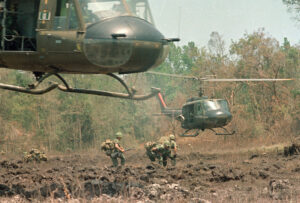
Touching down then waiting in those few fast seconds for the grunts to jump off makes everyone sitting ducks for the bad guys to fire on. A hot LZ is frightening – get in and get out without getting hit or worse, crewmen being wounded or killed. Not the place to be for longevity.
Part of the assault fire support is provided by the gunship platoon – The Firebirds. Not only guardian angels, but aggressive angels. the Firebirds provide escort and aerial fire reconnaissance for the troop-carrying slicks. Once the slicks land, the ‘guns’ will remain overhead providing additional covering fire support to both the slicks and the grunts now on the ground. Sometimes it’s easy in and easy out – other times, a huge battle ensues that can last for hours and hours.
Sitting on the ground in those fast first seconds was not for me, I needed to join the Firebirds. A motley group of aggressive, anti-authority, alcohol abusers who cared nothing about anything other than flying, shooting, and killing – my kind of guys. I was happy to be part of this august group of malcontents. 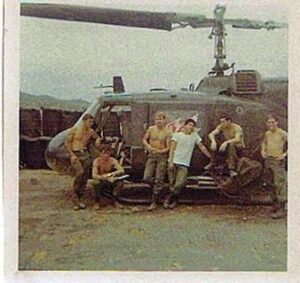
Although home based with the Rattlers base camp at Chu Lai, the Firebirds mission was the around the clock standby at LZ Baldy some 45 miles north of Chu Lai. Two gunships provided fire support to the 196th LIB units. Crew rotations occurred every two or three days depending on the mission requirements. The Baldy staging area included a rustic tin-roofed shack that was a quick reaction operations center and combined crew dormitory.
The shack, affectionately named the Firebird Hilton, was fifty feet from the gunships, had a direct land-line to the 196th operations center, and had about 20 steel framed bunks for overnight stays. In addition to the eight regular Firebird crews, the overnight complement also included one Rattler slick crew assigned as the ‘flare ship’ if needed to provide overhead illumination for night operations.
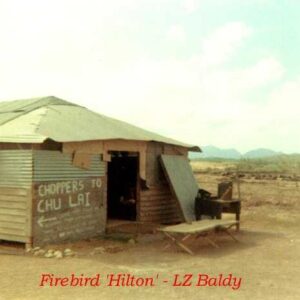
Not included was food, water, latrine, or other creature comforts. What was included was a hot, dirty, and dusty spot where you slept with your clothes and boots on to respond for the five-minute reaction call. Staying at Baldy was routine for the ‘Bird crews, the slicks hated it.
One notch above the grunts in the jungle, but better than nothing. The tour of duty included helping clean out and rearm the gunships after missions, maintaining the ammo supply CONEX, assembling rockets, taking care of the Firebirds dogs, and selling one-way tickets to Chu Lai aboard the Rattlers evening departures to Chu Lai – just kidding on that last one. Choppers to Chu Lai were nightly return slick flights for anyone looking for a ride to Chu Lai.
Firebird gunships were three configurations – hog that held only two 19 shot rocket pods, frog that held two 19 shot rocket pods and nose mounted 40 mm cannon, mini-gun ship with two seven shot rocket pods and two six-barrel rapid firing 7.62 mm gatling type guns. All three configurations carried two door gunners sporting 7.62 mm M-60 machine guns. Each door gunner was equipped with 3,000 rounds of 7.62 mm, extra barrels, gun lube, and an asbestos glove to change out a hot barrel in flight.
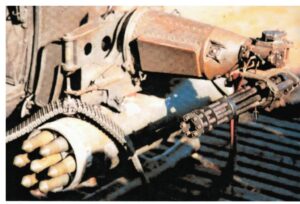
Rockets were either ten lb. or seventeen lb. high explosive warheads – other options included white phosphorus, flechettes, or smoke markers. The 40 mm canon fired 300 – 500 rounds. All in all – formidable fire support for most missions. More firepower than most municipal police departments and all the responsibilities given to 19 – 21-year-old pilots fresh from home.
Both gunships are 100 feet from the Firebirds Baldy standby hootch – always fully armed, fueled, and ready to go at a moment’s notice. The fuel control and throttles are set to start once the battery switch is turned on – battery on, pull the start trigger, spool up the turbine engine to full throttle open, all instruments ‘green’ – ready to lift off in less than a minute.
Clear left, clear right – Firebirds call to Baldy control tower for a scramble departure. As the Birds clear the airfield boundary – all weapons systems are armed and set to ‘safe’ – door gunners have loaded their belt fed M-60 machine guns. Spare barrels, lube, and asbestos gloves, all ready. The Firebirds gunships were armed with more firepower than most metro police departments. 20-year-old Warrant Officer pilots with 19- & 20-year-old crews who had complete faith and confidence in each other. Firebirds are eager for war.
The TOC landline screeches, the Firebirds fire team leader (FTL) responds and receives the pertinent mission details for a quick launch. While the FTL is ‘on the phone’ the other crews run to the gunships, start engines, and ready for departure when the FTL straps in the lead aircraft. Seconds later both aircraft make fast departures from Baldy into the AO and toward their assigned mission.
The multitude of missions could include reconnaissance by fire, helping the good guys locate the bad guys and then making the bad guys dead guys.
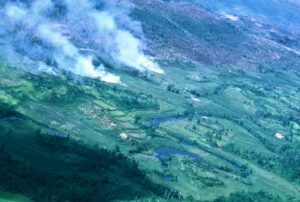
Rearranging local real estate for community redevelopment purposes, relocating non-paying tenants thereby creating new opportunities for the economy. Other services included squatter removal, controlled burns (for environmental purposes), and assisting population reduction through new political redistricting programs. The use of military grade weapons supplied through international treaty agreements proved to be very effective and beneficial. A win-win.
When the Firebirds were called in, it was because trouble was brewing. If trouble wasn’t brewing, the Firebirds were good at brewing trouble of their own. Infantry units in contact with Charlie was a great way to exercise aerial target practice. Infantrymen always appreciated the arrival of the ‘Birds – and were never disappointed. Helicopter gunships in Vietnam were aerial infantry – the only two combat groups that faced and fired directly at enemy targets with the targets most times returning fire. Army combat infantrymen were awarded the CIB – the Combat Infantryman Badge. No badges of combat honor or distinction, but Army combat helicopter pilots had the better war stories in the bar. Army commanders favored the grunts and despised the aviators – except for needed resupply or to haul their asses out of trouble.
After arriving in the Firebirds platoon in mid-December and receiving quick orientations on gunship equipment, it was away to Quang Tri some 150 miles north usually with a fuel stopover south of Danang at Marble Mountain.
Quang Tri was the staging area for Command & Control North (CCN)’sneaky pete’missions that would take us Laos.
(c) Copyright – 2023 Vic Bandini